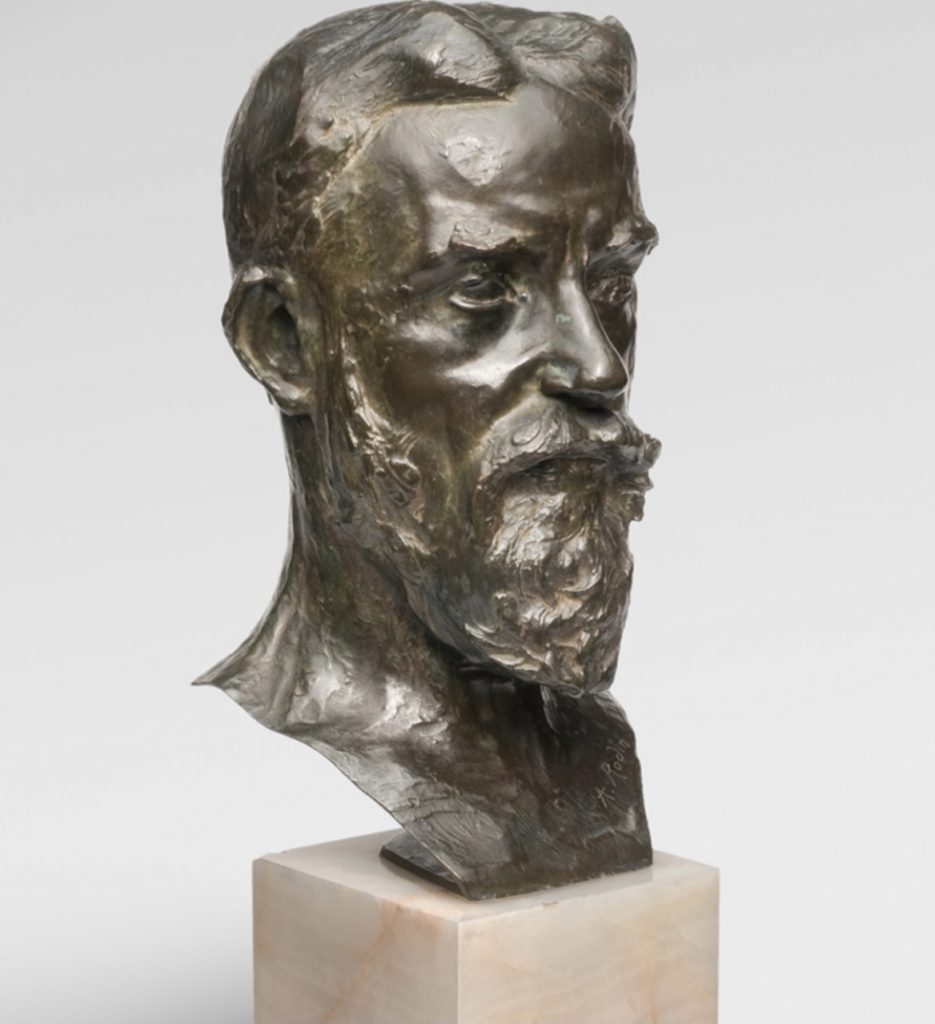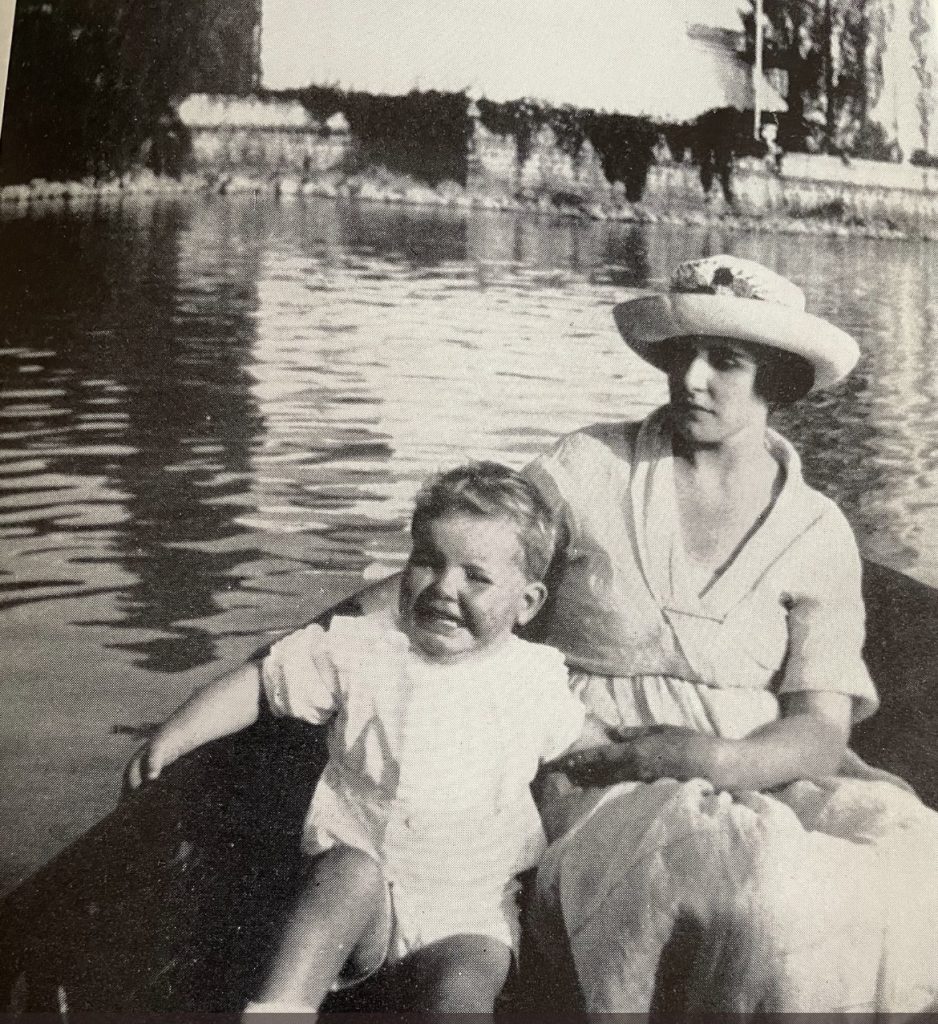George Bernard Shaw (1856-1950), the famous playwright and Fabian socialist, was a devoted vegetarian like Troubetzkoy. They became firm friends, with the playwright modelled three times over twenty years.
The story begins with another great Shavian bust by the towering genius Auguste Rodin. The original plaster of Rodin’s bust was created in the sculptor’s Paris studio in 1906.
Shaw maintained that the Rodin bust was the only likeness that revealed his inner self. He explained that only Rodin could penetrate the “mask” of his sitter’s reputation. “Look at my bust, and you will not find it a bit like the brilliant fiction known as GBS. But it is most frightfully like me.”

Shaw said that Rodin worked quite slowly, “as if he were a river god building a wall in a garden for 3 or 4 francs a day”. “When he was in doubt he measured me with an old iron divider, and then measured the bust. If the nose was too long, he sliced a bit off it, and jammed the tip up to close the gap, with no more emotion of affection than a glazier putting in a window pane. If the ear was in the wrong place, he cut it off and slapped it into the right place, excusing the ruthless mutilations to my wife (who half expected to see the already terribly animated clay bleed) by remarking that it was easier than to make a new ear. Yet a succession of miracles took place as he worked. In the first 15 minutes, in merely giving a suggestion of human shape to the lump of clay, he produced so spirited a thumbnail bust of me that I wanted to take it away and relieve him from further labour […] but that phase vanished like a summer cloud as the bust evolved […] (then) it sobered down into a careful representation of my features in their exact dimensions. Then it reverted to the cradle of Christian art, at which point I wanted to shout “For Heaven’s sake, stop: it is a Byzantine masterpiece. Then it began to look as if Bernini had meddled with it. Then, to my horror, it smoothed out into a plausible, rather elegant piece of 18th C. work, almost as if Houdon had touched up a head by Canova. At this point Troubetzkoy would have broken it with a hammer, or given up with a wail of despair. Then another century passed in a single night, and the bust became a Rodin creation, and was the living head […] It was a process for the embryologist to study, not the aesthete […]”
Shaw paid Rodin the highest possible compliment when he predicted his own epitaph as: Shaw, Bernard: sculpted by Rodin, otherwise unknown! His assessment of Troubetzkoy (“the most amazing sculptor of modern times”) was coloured no doubt by flattery: after all, he sat for the Russian on three separate occasions. He also wrote that Troubetzkoy was a “gigantic humanitarian who could do anything with an animal except eat it.”
Shaw observed that “when Troubetzkoy models an animal, be it the smallest spoiled pet, or an exhausted draft horse, in whose body one can see all the pains of the ill-treated animals who died without knowing human pity; or the horse subjugated by the terrible Czar, which stands out irresistibly in the great square of Leningrad, among the spaces left empty by the conventional monuments, swept away by the exasperation of the Soviets, so perfect is the result, so adherent to nature, such the impression that is aroused by its power of representation, to be compelled by us to conclude that his sculpture – like Barye’s – is created to model only, and nothing else, animals.”
Shaw knew of course that animal sculptures were just a small part of the Russian’s oeuvre. He knew that the sculptor would be remembered primarily for his busts and his statues of high society figures in Paris and London, impeccably dressed. So his legacy would be as the Singer Sargent of sculpture – in Shaw’s words “discovering the “quintessence of elegance in the draping of a skirt, in the head and arms of an archduchess”.
At the same time, Shaw recognised that Troubetzkoy’s genius transcended a mere society portraitist in clay. He pointed out that, when his countrymen from Lake Maggiore asked him for a memorial of the great war, Troubetzkoy placed, in the long lake of Pallanza, where he once lived beside the famous Villa Cabianca rock, a simple figure of a mother, who tends her child and asks: “Do you want to see my son?”
The first Troubetzkoy bust, in 1908, was created after the Russian saw the Rodin bust. He declared that there was no life in the eyes, and felt that he could do better. In five hours of frenzied work in the London studio of John Singer Sargent he produced his own bust of Shaw. (This was at the house in Tite Street, Chelsea which is still opposite the house where Oscar Wilde lived). Shaw remembered it as “a delightful and wonderful performance. He worked convulsively, giving birth to the thing in agonies, hurling lumps of clay about with groans, and making strange, dumb movements with his tongue, like a wordless prophet. He covered himself with plaster. He covered me with plaster. And, finally, he covered the block he was working on with plaster to such purpose that, at the end of the second sitting, lo! there stood Sargent’s studio in ruins, buried like Pompeii under the scoriae of a volcano, and in the midst a spirited bust of one of my reputations, a little idealized (quite the gentleman in fact) but recognisable a mile off as the sardonic author of Man and Superman, with a dash of Offenbach, a touch of Mephistopheles, and a certain aristocratic delicacy and distinction that came from Troubetzkoy himself, he being a Russian prince. I should like to have that bust; but the truth is that my wife couldn’t stand Offenbach-Mephistopheles; and I was not allowed to have the bust […]” (This explains why only the Rodin bust greets visitors to Shaw’s Corner in Hertfordshire).
Many years later Shaw went to Troubetzkoy’s studio in Verbania, Italy for full body sculptures. His visits to Lake Maggiore were to have a profound influence on his later plays, but it was not just the magical scenery that stimulated his creative imagination.
In the late Summer of 1921, an American girl, Molly Tompkins, came to London for the express purpose of meeting the great playwright. Shaw bumped into her outside his house in Adelphi Terrace and invited her in for ‘buttered crumpets’. She explained that, with her husband Laurence, she wanted to create a Shavian theatre. Although he found Molly ‘as vain as a goldfish’, her eagerness “softened my stony heart a little”. He realised that Molly brought out qualities he shared with Henry Higgins in Pygmalion. No surprise therefore that he saw something of Eliza Doolittle in her, and sent her for lessons in diction with Professor Daniel Jones at London University.

When Molly and Laurence went to Italy in Spring 1926, she invited George Bernard Shaw to join them. On the 5th of August he and his wife Charlotte arrived at the Regina Hotel at Stresa, overlooking Lake Maggiore. They were enlivened by local residents including the conductor Albert Coates and his wife Dooshka – a ‘Prima Donna from Moscow’. Fellow guests included Cecil Lewis who later shared an Oscar for the screenplay of Shaw’s Pygmalion.
Shaw spent his time ferrying across the lake to sit for Prince Paul Troubetzkoy who had a ‘big studio’ and an “astonishing wife”. Shaw posed for a statuette showing him seated in July 1926. One of the stops on the lake was the tiny island of San Giovanni, which was being rented by Molly Thompkins. ‘I cannot tear myself away from the Isola Molli’ wrote Shaw, who went on excursions with her to Baveno.
The following year Shaw returned to the Regina Palace – once again to pose for Troubetzkoy.
Shaw described how he took up his ‘platform pose as an orator’ when he gave ‘twenty sittings, or rather standings’ for the final portrayal at Troubetzkoy’s studio. Only one bronze cast was made from it. It captures the combative nature of a subject with an opinion on everything, whose moustache bristles as he contemplates a suitable repartee. He was only upset that it was not exhibited at the National Gallery of Ireland during his lifetime. He accepted the (then) rule that only portraits of deceased subjects were displayed.
Shaw claimed to have saved the sculptor from despair over the 1927 death of his wife Elin Sundström by agreeing to return to Verbania for the final sitting. However, it was also a convenient excuse to meet Molly Thompkins at the Isolino San Giovanni. She left an indelible mark on his creative output. Molly and her “love-island” lingered like a sea-fantasy over his last plays and continued to haunt his memory. ‘The restless hands sometimes tire of the pen and remember the road to Baveno’ he wrote her: ‘…angels will always love you, including George Bernard Shaw’!
References
1 Shaw: An Autobiography 1898 – 1950, selected from his writings by Stanley Weintraub
2 Paul Troubetzkoy by George Bernard Shaw
